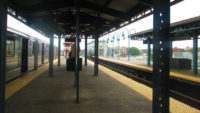Transit
AECOM-HNTB Team Wins $186M Contract to Manage NYC Second Avenue Subway Extension

The second phase of the Second Avenue subway project would extend the line 1.76 miles and add three stations.
Rendering courtesy MTA
The board of New York’s Metropolitan Transit Authority voted on March 26 to approve a $186.6-million contract with AECOM-HNTB JV for project management consultant services on MTA’s $7.7-billion Second Avenue subway extension second phase.
The joint venture is a team of AECOM USA Inc. and HNTB New York Engineering and Architecture PC. The JV will be responsible for overseeing work under three of four construction contracts associated with the project for a 91-month contract term. The firms did not immediately respond to inquiries about the project.
“We want to grow our capacity on a temporary basis,” Janno Lieber, CEO of MTA, said during a press conference after the meeting. He added that the firms bring expertise in areas such as tunnel boring and complex systems beyond the “meat and potatoes transit stuff like tracks and signals” that MTA staff typically focus on.
MTA is planning to extend the Second Avenue subway line about 1.76 miles from 96th Street to 125th Street, and to add stations at 106th, 116th and 125th streets.
The agency says it received three responses to its request for proposals. The other proposals came from Bechtel Infrastructure Corp. and Second Avenue Subway East Harlem Collaborative, a JV of Jacobs and TYLin Engineering, records show. MTA staff wrote that AECOM-HNTB originally proposed a cost of $238.4 million, and they reached the agreed not-to-exceed price through negotiations.
AECOM was also part of a design and engineering joint venture that contributed to the first phase of the Second Avenue subway project. The line began operating at the beginning of 2017.
Contract Packages
MTA awarded a $182-million contract in December 2023 to Queens-based C.A.C. Industries Inc. for utility relocation and building remediation/protection. While that work paused for a time last year amid concerns over funding related to congestion pricing tolls in much of Manhattan, work has resumed. Managing this contract does not fall under the scope of work awarded to AECOM-HNTB.
The second construction contract covers rehabilitation of an existing tunnel segment, plus tunnel boring, construction of cross passages and construction of shells for the stations at 116th and 125th streets. It is currently in procurement, according to MTA.
The third contract would cover construction of the tunnel and structural shell for the 106th Street station, and the fourth’s scope is planned to include construction of station entrances and ancillary buildings, plus fit-out of stations and tunnels.
During its meeting, the MTA board also voted to approve a $59.96-million contract modification with Phase 2 Partnership, a joint venture of WSP USA Inc. and STV Inc., for advancing design for the fourth construction contract. Phase 2 Partnership’s base contract was valued at $120.5 million and was previously increased to $195.5 million.
Costs and Funding
MTA is funding the subway extension in part with $3.4 billion the Federal Transit Administration agreed to provide in November 2023. The project is also part of a slate of work that MTA officials have planned to fund using $15 billion in bonds to be paid down with tolls from New York City’s congestion pricing program south of 60th Street in Manhattan. Last month, U.S. Dept. of Transportation officials said they were rescinding approval for the first-in-the-country program, but MTA is continuing the program as it sues DOT officials, seeking to have the termination declared null.
The estimated $7.7-billion cost of the project has drawn criticism, similar to the $4.5-billion first phase. But instead of considering the cost on a per-mile basis, Lieber said cost should instead be thought of in terms of how many riders the system serves and compared the subway’s ridership to the number of people who fly in the U.S. As of 2023, the subway had a daily ridership of about 3.6 million, according to MTA, compared to 2.9 million daily airline passengers, according to the Federal Aviation Administration.
“You have to … have systems that serve more people if you have a bigger ridership,” Lieber said. “And by the cost-per-rider standard, we are at the low end of actual costs.”


